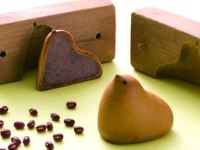Since classic Japan is not EEOC, this girls' holiday is not a national holiday while the boys' holiday, May 5, is. It is called こどもの日 "Kodomo no hi", or Children's Holiday in current Japan, so it is officially non-gender but it is traditionally the holiday for boys.
Please check Wikipedia for extra details about Hina-matsuri if you're interested; here is an overview. The girls' holiday Hina-matsuri is the day for the Hina dolls decoration. Hina (hiina) is an archaic name of dolls in Japanese and the holiday for Hina became Hina-matsuri. Based on local tradition, the holiday involves a special set of dolls. This decorative display came to be called "Hina-ningyo (ningyo means dolls)".
The Hina-ningyo doll set is quite a common gift for a baby girls' first March 3. The most common set is a 7-step display as shown above. A red carpet covers the 7 staircase-like platforms and the dolls are placed on each step-like platform in a certain order. This represents a wedding of Emperor (not sure which Emperor). The one my sister and I had for some reason had a description saying it was Emperor Tenchi (from the 8th century) but it is more common to be an anonymous emperor in the Heian era (8-12th century).
The order of the dolls are as follows:
The top level: the Emperor (O-dairi-sama) and Empress (O-hina-sama). Actually the "dairi" means the couple of Emperor and Empress but currently "dairi" usually means just the Emperor. "O" is a common prefix in Japanese to indicate respect. Some left wingers don't like to imply the festival as celebrating the wedding of the Emperor, so "otoko-bina (male hina)" and "onna-bina (female hina)" are used for more neutral names for the doll couple. Ohina-sama also means the whole set of dolls.
The second level: 3 court ladies called "San-nin (3 people) kanjo (court ladies-in-waiting)"
The third level: 5 male musicians called "Go-nin (5 people) bayashi (musicians)".
The fourth level: 2 ministers, a Minister of the Right Court, and a Minister of the Left Court.
The fifth level: 3 helpers -- one is crying, one is laughing and one is in anger.
Between these dolls, food and plants for the wedding are placed; and the sixth and seventh level platforms hold the furniture, palanquin and cow carriage.
However, the 7-platform set can be quite expensive, and big too. Many people in big cities don't have such space at home to decorate the big 7 platform sets, so there are smaller sets available: a 5- platform set, a 3-platform set, and a set with only the Emperor and Empress. The set usually comes encased in glass, like the one in the right.
Some families pass their hina-doll set over from one generation to the next, so it is not so unusual to see sets that are over 100 years old. If you visit Japan around this holiday, lots of museums show museum pieces of old hina dolls set. If you visit and want to see one of them, please contact us. I'll look up some places for you that have such sets on display.
For traditional girls, decorating the dolls is a favorite activity, in the same way Western folks love to decorate Christmas trees. And, putting away the doll set right after the holiday is also important. We used to say that a girl will be late to marry if she procrastinates in putting away her Hina dolls. Now we don't have the same mindset as years ago, that girls should marry early. In fact Japan is among the highest for the average age of women marrying. So the date to decorate the dolls are not very much fixed. Every girl knows though, that the doll set should be put away after the holiday.
Kawari-bina fashion
I don't know when it started but some time in the middle of the Showa era (sometime in the 60's), hina doll theme sets came into fashion. A set, usually only with the marrying couple, is arranged based on a well known event from the year before. Like, a long time ago, they had a set to commemorate the moon landing. This year, they have a set that represents the World Cup women's soccer champion team. Sets with zodiac animals are common, as is the Hello Kitty design shown here.
Also, you can view a how-to video of Origami (folding paper craft) for ohinasama. There are so many different ways of folding the Origami papers for ohinasama, it is a common activity in Japanese kindergarten and school around the time of February. Please see number 256 of the video which is the sequent video after this which shows the how-to of the head and accessory parts.
Japanese doll makers and department stores display hina doll sets for sale. Here are some links for the doll makers' sites:
Kyugetsu
Yoshitoku
Toei: This page shows a lot of "in the case" sets. They are favored by people without lots of extra space at home.
Mataro The way of this doll making is called "kimekomi", the wood body (seems resin mold now) "wearing" dress. Here is introduction video of kimekomi from Smithsonian. And this is more detailed video, she has the following videos as well.
















